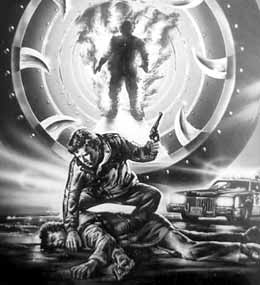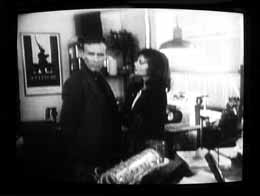
 A
New York female artist collects confessions of guilt on her answering
machine as a part of her latest art-object. Doing this she attracts
a schizophrenic serial killer who first sees her as his "confidante"
but soon also threatens her life. Routinely directed thriller full
of suspense. The combination with statements on the connection of
art and life have a fabricated, superficial effect. USA/Kanada 1986,
Produktion: Peregrine Entertainment / A.S.A.P. Director: Robert Bierman,
Music: Maurice Jarre, Actors: Lesley Ann Warren, Peter Weller, George
Loros, John Glover, James Ray Weeks (Rowohlt Lexikon des Internationalen
Films 1995) 'Apology' brings up research as an artistic working method
in the mid eighties. A method that also comes up widespread in the
art of the 90`s. However, in this Film the results of research become
part of a mechanical metal sculpture. It looks like the rests of a
science fiction movie set turned into a sculpture. Through its gigantic
size the artwork can clearly be read as an 80`s work. The object itself
looks like a kind of oversized manager toy... working with the method
- if I do something with it, something will move. On one level you
can read the film as a message of the 80`s not to cross the border
betwen art and life - and for example not to turn back to the 70`s
critical realism which is one possible point of contact. The artists
working interest in everyday misery of the "real world" finally exemplarly
fails. Another point of contact would be the theme of sex murder also
important for the painters of the "Neue Sachlichkeit" in the 20`s
in Germany. There the artists "real life" sources were newspapers
on crimes and not the criminals themselves like in 'Apology'. But
the best example for the subject - art meets life - is the film itself.
Because it shows a typical point of view of a specific time on "the
art". 'Apology' chooses as its set the SOHO gallery scene (around
this time the center of the art world), adding an artist living in
a loft with a homeles guy in front of her door and a homocide detective
giving grumbling comments on art. With his figur the normal guy from
the street without special knowledge in todays art is introduced.
He doesn`t understand most of it or thinks that it is crazy but puts
up the right questions. The films climax is a kind of conversion and
confession of the artist: "I was so fixed on my plan, that I didn`t
think about the people becoming involved in it. There will never be
an excuse making the things that happened tolerable. And I know by
now, that everything what I do as an artist or beside my work will
influence the life of the people around me. This I may and will never
forget again." Like in most of the films about artists they are portrayed
as a species which secretes embarassing art philosophical bombast.
Fans of conspiration theories could read this as a mean revenge of
film art. But it`s just one aspect of the good work media film produced
in combining art and "everyday life".
A
New York female artist collects confessions of guilt on her answering
machine as a part of her latest art-object. Doing this she attracts
a schizophrenic serial killer who first sees her as his "confidante"
but soon also threatens her life. Routinely directed thriller full
of suspense. The combination with statements on the connection of
art and life have a fabricated, superficial effect. USA/Kanada 1986,
Produktion: Peregrine Entertainment / A.S.A.P. Director: Robert Bierman,
Music: Maurice Jarre, Actors: Lesley Ann Warren, Peter Weller, George
Loros, John Glover, James Ray Weeks (Rowohlt Lexikon des Internationalen
Films 1995) 'Apology' brings up research as an artistic working method
in the mid eighties. A method that also comes up widespread in the
art of the 90`s. However, in this Film the results of research become
part of a mechanical metal sculpture. It looks like the rests of a
science fiction movie set turned into a sculpture. Through its gigantic
size the artwork can clearly be read as an 80`s work. The object itself
looks like a kind of oversized manager toy... working with the method
- if I do something with it, something will move. On one level you
can read the film as a message of the 80`s not to cross the border
betwen art and life - and for example not to turn back to the 70`s
critical realism which is one possible point of contact. The artists
working interest in everyday misery of the "real world" finally exemplarly
fails. Another point of contact would be the theme of sex murder also
important for the painters of the "Neue Sachlichkeit" in the 20`s
in Germany. There the artists "real life" sources were newspapers
on crimes and not the criminals themselves like in 'Apology'. But
the best example for the subject - art meets life - is the film itself.
Because it shows a typical point of view of a specific time on "the
art". 'Apology' chooses as its set the SOHO gallery scene (around
this time the center of the art world), adding an artist living in
a loft with a homeles guy in front of her door and a homocide detective
giving grumbling comments on art. With his figur the normal guy from
the street without special knowledge in todays art is introduced.
He doesn`t understand most of it or thinks that it is crazy but puts
up the right questions. The films climax is a kind of conversion and
confession of the artist: "I was so fixed on my plan, that I didn`t
think about the people becoming involved in it. There will never be
an excuse making the things that happened tolerable. And I know by
now, that everything what I do as an artist or beside my work will
influence the life of the people around me. This I may and will never
forget again." Like in most of the films about artists they are portrayed
as a species which secretes embarassing art philosophical bombast.
Fans of conspiration theories could read this as a mean revenge of
film art. But it`s just one aspect of the good work media film produced
in combining art and "everyday life".
Conversation in a restaurant (retranslation from the German dubbed version)
Daughter of the artist: Hey stop, I don`t understand. Why do you tape all of those confesssions.
Artist:
This is for my new object. You can walk it and if you`re inside you
hear confessions which have to be  faced
by the visitors: horrible sins, crimes and so on. Yes, and I had the
idea that those confessions could also be real ones. I only have to
give people the oportunity to call someone and see what happpens.
(laughs)
faced
by the visitors: horrible sins, crimes and so on. Yes, and I had the
idea that those confessions could also be real ones. I only have to
give people the oportunity to call someone and see what happpens.
(laughs)
Daughter: Sounds pretty pretentious.
Gallery owner and former lover of the artist: (copies the italian accent of the succesful gallery owner who shows the artists work) I didn`t get you, did I? This is an intriguing edea and Bensini will make your mama a fortuna with her little game.
Artist (excited): Sorry but it is not a game and it is also not pretentious.
Gallery owner: What? Ooooh, it should help us to a better understanding of our fellow beings or perhaps even of ourselves.
Artist: It is not absolutely clear that this is impossible, or is it? There exists no law which says that we people have to pass each other without an interest in each other. Imagine yourself getting ridd of everything that depresses you and that me and other people could hear this... All of us would see that we are not all alone with our guild and lonlyness.
Eine New Yorker Künstlerin lockt durch ihr jüngstes Kunstobjekt, für das sie Schuldbekenntnisse auf einem Anrufbeantworter sammelt, einen schizophrenen Serienmörder an, der sie zunächst als seine "Vertraute" ansieht, bald jedoch auch ihr Leben bedroht. Routiniert inszenierter, äußerst spannender Thriller; die Verknüpfung mit Aussagen über den Zusammenhang von Kunst und Leben wirkt jedoch allzu konstruiert und oberflächlich. USA/Kanada 1986 P Peregrine Entertainment / A.S.A.P. R Robert Bierman B Mark Medoff K Phil Meheux M Maurice Jarre D Lesley Ann Warren, Peter Weller, George Loros, John Glover, James R. Weeks L 97 FSK ab 16 E 20.6.87 Video fd 26 331 (Rowohlts Lexikon d. Internationalen Films 1995)
Gespräch in einem Restaurant Zitate aus dem Film (deutsche Sychronisation)
Tochter der Künstlerin: Hey, moment mal, ich versteh das nicht? Wofür nimmst du denn diese ganzen Geständnisse auf?
Künstlerin: Das ist für mein neues Objekt. Das soll begehbar werden und wenn du drin bist, dann hörst du Geständnisse, und die müssen die Leute dann einordnen: gräßliche Sünde, Verbrechen und so weiter. Ja, und diese Geständnisse könnten doch auch echt sein hab ich mir dann gedacht. Ich muß den Leuten ja nur die Gelegenheit geben bei jemandem anzurufen und sehen was passiert.
Tochter: Klingt recht prätentiös, was?
Galerist, Ex-Liebhaber der Künstlerin: (Immitiert den italienischen Akzent des jetzigen, erfolgreicheren Galeristen der Künstlerin) Ich hör wohl nicht recht? Es ist unglaublichä Idää und Bensini wird machen deine Mama ein Vermögän mit ihre kleinä Spielerei.
Künstlerin (erregt): Entschuldigung, aber es ist keine Spielerei und es ist auch nicht prätentiös.
Galerist: Was dann? Ooooh, es soll uns dabei helfen unsere Mitmenschen besser zu verstehen oder vielleicht sogar uns selbst.
Künstlerin: Es ist nicht unbedingt gesagt, daß das unmöglich ist, oder? Es gibt ja kein Gesetz, das besagt, daß wir Menschen so desinteressiert aneinander vorbeigehen müssen. Stell dir doch mal vor, daß du jetzt alles los werden könntest was dich bedrückt und daß ich und andere Leute das dann hören würden... Da würden wir alle merken, daß wir gar nicht so allein dastehen in unserer Schuld und unserer Einsamkeit.
Gespräch in einem Kaffee/Imbiss
Journalist: Also ihren Plakaten nach zu schliessen würde ich denken, daß sie zur Gattung der Welterrettungskünstler gehören.
Künstlerin: Nein, die Welt zu erretten, das muß man den Politikern überlassen, das ist deren Sache, denke ich. Ich bin von daher ein reiner Selbsterrettungskünstler.
Journalist: Aha. Hat`s denn schon irgendwelche besonderen Geständnisse gegeben? Künstlerin: Eine Frau hat gebeichtet, daß sie ihrer Nachbarin immer die Zeitung klaut.
Journalist: Nein, ich meine so etwas wie Mord, Vergewaltigung, Kindesmißhandlung... Etwas in der Art.
Künstlerin: Tja. Heute früh hab ich einen Anruf abgehört... vielleicht war es nur ein dummer Scherz, jedenfalls hat jemand gestanden, daß er Homosexuelle ermordet und obwohl es in der Anzeige heißt, daß man anonym bleiben soll, hat er seinen Namen angegeben.
Journalist: Erschlägt er seine Opfer mit einem stumpfen Gegenstand?
Künstlerin: Das hat er nicht gesagt.
Journalist: Und anschließend schneidet er ihnen dann den Penis ab. In den letzten sechs Wochen sind fünf Homosexuelle auf die Art umgebracht worden. Wie wärs, wollen sie mir helfen den Pullitzer Preis zu gewinnen? Sagen sie mir seinen Namen.
Künstlerin: Das kann ich nicht.
Journalist: Wieso? Warum nicht?
Künstlerin: Ganz einfach weil...
Journalist: Hören sie, hier geht es nicht um irgendein künstlerisches Experiment, hier geht es um Mord.
Künstlerin: Sehen sie, ich weiß ja nicht einmal ob dieser Kerl mir nur einen Schrecken einjagen will.
Journalist: Nun gut, dann schlag ich vor, daß wir beide der Sache nachgehen, dann läßt sich herausfinden ob was dran ist. Da kann für uns beide was herausspringen. Kommen sie, überlegen sie doch mal.
Künstlerin (steht auf und geht): Ich hab einen Fehler gemacht.
Journalist: Was ist denn los? Wo wollen sie denn hin?
Künstlerin: Ich hätte ihnen das nicht sagen sollen.
Journalist: Wem dann? Der Polizei? Moment... Mo... Mo... Moment, das war doch nicht ernst gemeint... Bleiben sie doch da... Künstlerin: Taxi